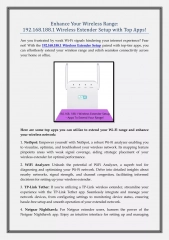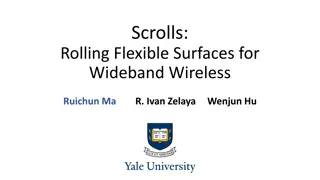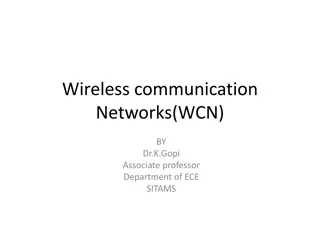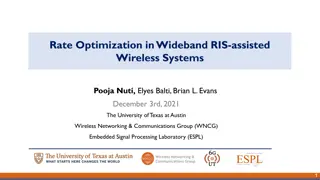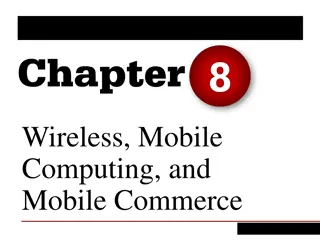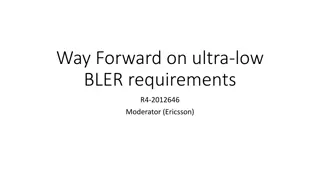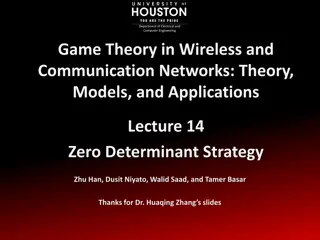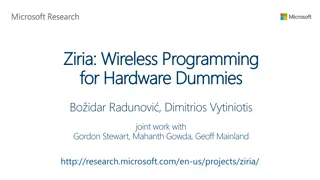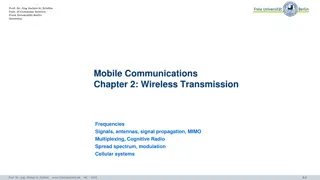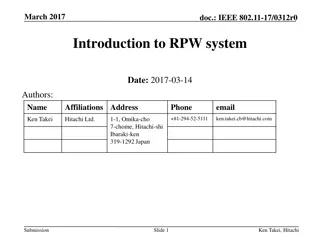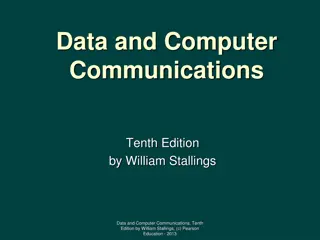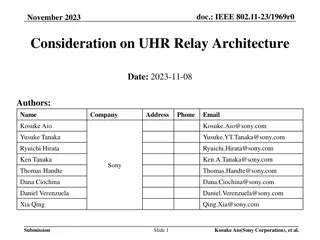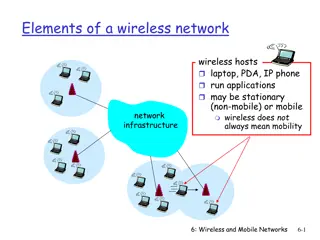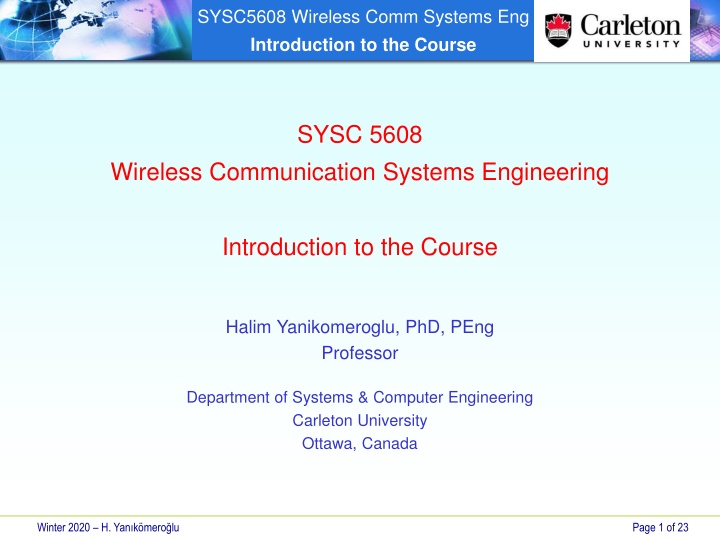
Introduction to Wireless Communication Systems Engineering
This course introduces wireless communication systems engineering, covering topics such as electromagnetic waves, ITU radio bands, wireless communications, mobile communications, and the complexity of wireless systems. It delves into the multi-disciplinary nature of wireless engineering, involving electrical engineering, computer science, and applied mathematics. Explore the fundamentals and intricacies of wireless technologies through a comprehensive overview presented by Professor Halim Yanikomeroglu, PhD, PEng, from Carleton University.
Uploaded on | 1 Views
Download Presentation

Please find below an Image/Link to download the presentation.
The content on the website is provided AS IS for your information and personal use only. It may not be sold, licensed, or shared on other websites without obtaining consent from the author. If you encounter any issues during the download, it is possible that the publisher has removed the file from their server.
You are allowed to download the files provided on this website for personal or commercial use, subject to the condition that they are used lawfully. All files are the property of their respective owners.
The content on the website is provided AS IS for your information and personal use only. It may not be sold, licensed, or shared on other websites without obtaining consent from the author.
E N D
Presentation Transcript
SYSC5608 Wireless Comm Systems Eng Introduction to the Course SYSC 5608 Wireless Communication Systems Engineering Introduction to the Course Halim Yanikomeroglu, PhD, PEng Professor Department of Systems & Computer Engineering Carleton University Ottawa, Canada Winter 2020 H. Yan k mero lu Page 1 of 23
SYSC5608 Wireless Comm Systems Eng Introduction to the Course What is Wireless Communications? 1/2 Electromagnetic waves Mainly, radio waves (3 KHz to 300 GHz or 3 THz) [http://en.wikipedia.org/wiki/Radio_spectrum] Winter 2020 H. Yan k mero lu Page 2 of 23
SYSC5608 Wireless Comm Systems Eng Introduction to the Course ITU (International Telecommunications Union) Radio Bands ITU Radio Bands HF Frequency Range (f) 3 MHz Wavelength Range ( ) 100 m 30 MHz 10 m VHF UHF 30 MHz 300 MHz 300 MHz 10 m 1 m 1 m 3 GHz 10 cm 1G 4G SHF 3 GHz 30 GHz 10 cm 1 cm EHF 30 GHz 300 GHz 1 cm 1 mm mmWave THF 300 GHz 3 THz 1 mm 0.1 mm THz comm Carrier frequency vs bandwidth Wavelength: = c/f, where c = 3x108 m/s and f is the carrier frequency (Hz) Bandwidth: Difference between upper and lower frequencies around the carrier Winter 2020 H. Yan k mero lu Page 3 of 23
SYSC5608 Wireless Comm Systems Eng Introduction to the Course What is Wireless Communications? 1/2 Electromagnetic waves; travel through vacuum Mainly, radio waves (3 KHz to 300 GHz or 3 THz) [http://en.wikipedia.org/wiki/Radio_spectrum] Some use wireless communications and radio communications interchangeably; but, a) radio generally highlights only the propagation aspect, b) not all wireless is radio. Wireless is much broader than radio . Likewise, some use mobile communications and radio communications interchangeably. But, wireless has many other aspects in addition to being mobile . More recently: terahertz comms, free-space optical (FSO) comms Mechanical waves; requires a material medium (outside our scope) Ex: Sound waves (20 Hz 20 KHz); not electromagnetic Winter 2020 H. Yan k mero lu Page 4 of 23
SYSC5608 Wireless Comm Systems Eng Introduction to the Course What is Wireless Communications? 2/2 A large number of phenomena, components, and sub-systems Ex: Fading phenomenon Interacting in highly complex manners Ex: 5G wireless networks Wireless systems may be very complex Ex: 4G LTE and LTE-Advanced standards: thousands of pages One of the most advanced and sophisticated engineering systems ever Wireless is a multi-disciplinary area Electrical engineering, computer engineering, computer science, applied mathematics, Winter 2020 H. Yan k mero lu Page 5 of 23
SYSC5608 Wireless Comm Systems Eng Introduction to the Course SYSC 5608 Scope Wireless: different from wired communications Limited power and bandwidth limited capacity Channel inferior quality Broadcast nature Users are tangled Network problem (not a link problem) Layers in the protocol stack L0: Propagation L1: Physical layer (PHY) L2: Medium access layer (MAC) L3: Networking layer (NET) *** ** *** * Note that L0 and L2 are the distinguishing layers Winter 2020 H. Yan k mero lu Page 6 of 23
SYSC5608 Wireless Comm Systems Eng Introduction to the Course SYSC 5608 Scope Wireless: very broad many courses SYSC 5608 systems course touches upon all layers and many applications less focused ELG 5133 (SYSC 5606) Introduction to Mobile Communications more focused, mainly PHY ELG 7177C Topics in Comm. 1: Wireless Ad Hoc Networking One important application ELG 5132 Smart Antennas One important PHY technology SYSC 5403 Network Access Techniques SYSC 5700 Spread Spectrum Systems One important multiple access scheme SYSC xxxx Topics in Comm.: Cross-Layer Design Winter 2020 H. Yan k mero lu Page 7 of 23
SYSC5608 Wireless Comm Systems Eng Introduction to the Course Protocol Layers Understanding propagation and channel propagation modeling received power received power s large-scale and small-scale variations and statistics L1 PHY: Developing techniques to improve the performance for a given channel (SNR and it s statistics) [Why SNR statistics is important?] channel coding diversity equalization, L2 MAC: Sharing the medium and radio resources radio resource management (RRM) L3 NET: Sharing the radio access network (RAN) routing, Winter 2020 H. Yan k mero lu Page 8 of 23
SYSC5608 Wireless Comm Systems Eng Introduction to the Course Protocol Layers L2 + L3: for each terminal, determine at what time to transmit (time scheduling) at what frequency to transmit (frequency scheduling) at what power to transmit (power scheduling) at which PHY mode to operate (eg., adaptive modulation and coding) to which RAN element to connect (macro-BS, pico-BS, WiFi-AP, relay, ) based on (objective function and constraints) maximizing user rate (throughput) maximizing aggregate network throughput minimizing latency attaining fairness (ubiquitous coverage) maximizing energy efficiency L2 + L3: assignment problems optimization Winter 2020 H. Yan k mero lu Page 9 of 23
SYSC5608 Wireless Comm Systems Eng Introduction to the Course Why Should You Know Wireless? ICT (information and communication technologies): trillion-dollar industry Wireless: one of the most essential components of ICT Its relevance will increase substantially in the foreseeable future vertical industries Work opportunities Vendors (Ericsson, Huawei, Nokia, ) Operators (Bell Mobility, Rogers, Telus, ) Chipmakers (Intel, Qualcomm, MediaTek, Broadcom, ) Start-ups Other ICT/computing industries (Google, Amazon, Facebook, ) Verticals (health, automotive, agriculture, defence, entertainment, ) Government Graduate studies Winter 2020 H. Yan k mero lu Page 10 of 23
SYSC5608 Wireless Comm Systems Eng Introduction to the Course Remarks I will use the slides as well as the board You are responsible from both Beginning of each day: A brief discussion about Previous lectures Emerging wireless technologies Other technical concepts Career related issues, graduate studies Popular topics I will provide light reading materials Subscribe to wireless news portals, such as FierceWireless @ http://www.fiercewireless.com Winter 2020 H. Yan k mero lu Page 11 of 23
SYSC5608 Wireless Comm Systems Eng Introduction to the Course Remarks From me I have been preparing for this course for 30 years Not an over-the-weekend preparation An area that I know well; I have expertise in many sub-areas I am excited and highly motivated Winter 2020 H. Yan k mero lu Page 12 of 23
SYSC5608 Wireless Comm Systems Eng Introduction to the Course Remarks From me I have been preparing for this course for 30 years Not an over-the-weekend preparation An area that I know well; I have expertise in many sub-areas I am excited and highly motivated From you Make sure that you have sufficient background in digital comm Attend lectures Be motivated, show interest, take it serious, work hard Most important factors in success! Utilize the opportunity Winter 2020 H. Yan k mero lu Page 13 of 23
SYSC5608 Wireless Comm Systems Eng Introduction to the Course Remarks From me I have been preparing for this course for 30 years Not an over-the-weekend preparation An area that I know well; I have expertise in many sub-areas I am excited and highly motivated From you Make sure that you have sufficient background in digital comm Attend lectures Be motivated, show interest, take it serious, work hard Most important factors in success! Utilize the opportunity I want to give good grades; please help me! Winter 2020 H. Yan k mero lu Page 14 of 23
SYSC5608 Wireless Comm Systems Eng Introduction to the Course Course Approach 1/5 The course includes both analysis and synthesis parts. This course has the systems view (not a physical layer course, not a networking course; rather, a systems course) The emphasis is on the multiple access and related issues; the course also covers certain aspects of radio propagation, physical layer, medium access control (MAC) layer and networking layer. The course covers a broad range of topics: Fundamental dynamics Components in isolation Integrated systems Therefore, this is an introductory graduate course Winter 2020 H. Yan k mero lu Page 15 of 23
SYSC5608 Wireless Comm Systems Eng Introduction to the Course Course Approach 2/5 One way of partitioning wireless: Cloud Pipe Devices which are all tangled. This course is mainly on the pipe (connectivity), but we will cover certain aspects of wireless devices (for instance, signal processing and algorithmic aspects) as well as the cloud (super network). Winter 2020 H. Yan k mero lu Page 16 of 23
SYSC5608 Wireless Comm Systems Eng Introduction to the Course Course Approach 3/5 Two fundamental questions in wireless: This course addresses the following fundamental question: How can we increase the performance of wireless networks by efficient utilization of the cloud, pipe, and devices? Increasing performance Increasing rate Increasing reliability Decreasing latency (delay) Increasing energy efficiency Decreasing cost Winter 2020 H. Yan k mero lu Page 17 of 23
SYSC5608 Wireless Comm Systems Eng Introduction to the Course Course Approach 4/5 Two fundamental questions in wireless: The second fundamental question, What can we do with the achieved performance? , will be touched upon briefly. Applications in health care, intelligent transportation systems, energy network, , through novel protocols, software, devices. Winter 2020 H. Yan k mero lu Page 18 of 23
SYSC5608 Wireless Comm Systems Eng Introduction to the Course Course Approach 5/5 Food for thought: Which question is more important? Q1: How can we increase the performance of wireless networks by efficient utilization of the cloud, pipe, and devices? Q2: What can we do with the achieved performance? Winter 2020 H. Yan k mero lu Page 19 of 23
SYSC5608 Wireless Comm Systems Eng Introduction to the Course Topics Covered 1/4 Actual coverage (as we progress) will be listed on the course web site. Introduction Defining wireless Historic view Emerging issues dB notation Propagation and Link Budget Antennas Pathloss in different wireless environments Large scale signal variation: Shadowing, reflection, diffraction, scattering, coverage Multipath and small scale signal variations Channel measurements and simulation Link budget Winter 2020 H. Yan k mero lu Page 20 of 23
SYSC5608 Wireless Comm Systems Eng Introduction to the Course Topics Covered 2/4 Cellular Communications Cellular communications principles Multiple access methods: FDMA, TDMA, CDMA, OFDM, random access Interference characterization Capacity, outage Macrocell, microcell, picocell, radio-over-fiber, distributed antennas 1G, 2G, 3G, 4G, 5G cellular networks Wireless Channel Characterization Multipath fading Coherence time, Doppler spread Coherence bandwidth, power delay profile Winter 2020 H. Yan k mero lu Page 21 of 23
SYSC5608 Wireless Comm Systems Eng Introduction to the Course Topics Covered 3/4 Digital Modulation and Interference Spectral efficiency Digital modulation methods Error performance in interference and fading Diversity and Adaptive Equalization Principles, types and performance of diversity combining Adaptive equalization techniques for combating multipath Systems Issues Scheduling Call admission control Multiuser diversity Interference management Radio resource management Routing Winter 2020 H. Yan k mero lu Page 22 of 23
SYSC5608 Wireless Comm Systems Eng Introduction to the Course Topics Covered 4/4 Miscellaneous Non-terrestrial networks 6G networks Sensor networks Cognitive radio Multihop/mesh/relay networks Cooperative communications WLAN (802.11) Winter 2020 H. Yan k mero lu Page 23 of 23

